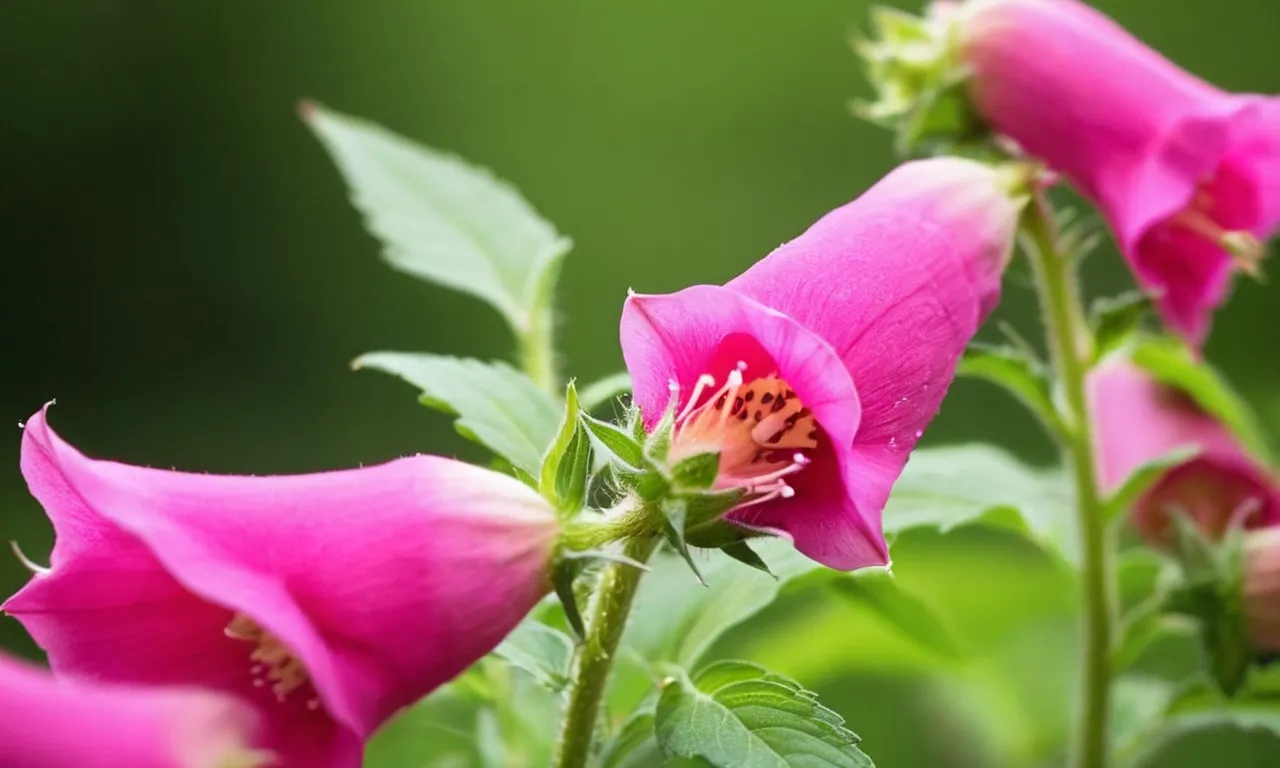Foxglove Meaning Flower: Exploring The Symbolism And Significance
In the vast tapestry of the floral kingdom, the foxglove stands tall, captivating our senses with its striking beauty and rich symbolism. This enchanting bloom has long been revered for its medicinal properties and has woven itself into the fabric of folklore and literature, leaving an indelible mark on our collective consciousness.
If you’re short on time, here’s a quick answer to your question: The foxglove flower holds a multitude of meanings, ranging from insincerity and insecurity to healing and protection. Its symbolism is deeply rooted in its historical use as a medicinal herb, as well as its association with fairies and the mystical realms.
In this comprehensive article, we will delve into the fascinating world of the foxglove, unraveling its symbolic significance, exploring its cultural and literary connections, and unveiling the captivating tales that have been woven around this enchanting bloom.
The Foxglove’s Symbolic Meanings
Insincerity and Insecurity
The foxglove flower, with its striking appearance and intriguing history, has long been associated with the symbolism of insincerity and insecurity. This interpretation stems from the plant’s toxic nature, which has led some to believe that it represents deceit or hidden dangers. According to the Old Farmer’s Almanac, the foxglove’s symbolism of insincerity is rooted in its ability to cause harm if ingested, representing the potential for falsehoods or untrustworthiness.
Furthermore, the foxglove’s delicate and drooping bell-shaped blossoms have been linked to feelings of insecurity or a lack of self-confidence. This symbolism may be derived from the flower’s vulnerability to harsh weather conditions or its tendency to wilt quickly after being picked.
As such, the foxglove can serve as a gentle reminder to embrace one’s authentic self and find strength in vulnerability. 😊
Healing and Protection
Despite its potentially harmful properties, the foxglove also carries symbolic meanings of healing and protection. This duality reflects the plant’s medicinal history, as it has been used for centuries to treat various ailments, particularly heart conditions. According to The Spruce, the active compound in foxglove, digitoxin, has been instrumental in developing modern heart medications, making it a symbol of life-saving remedies.
Moreover, the foxglove’s tall, erect stems and vibrant blooms have been associated with protection and warding off negative energies. In some folklore traditions, it is believed that placing foxglove flowers around the home or carrying them as a talisman can shield against harm or ill intentions.
This symbolic meaning is often linked to the plant’s ability to thrive in challenging environments, making it a representation of resilience and perseverance.
Fairies and Mystical Realms
Steeped in folklore and mythology, the foxglove is also closely tied to the symbolism of fairies and mystical realms. Its whimsical bell-shaped flowers are believed to be the perfect hiding spots for tiny fairies, lending an air of enchantment and magic to the plant. According to The Woodland Trust, the foxglove’s association with fairies dates back to ancient Celtic traditions, where it was believed that the blossoms would ring like bells to summon the fae folk.
This symbolic meaning has endured through the centuries, with the foxglove often appearing in fairy tales, children’s stories, and artistic depictions of mystical realms. Its presence in these narratives serves to evoke a sense of wonder and transport the reader or viewer to a world where the boundaries between reality and fantasy blur.
The foxglove’s connection to fairies and mystical realms invites us to embrace our sense of imagination and curiosity, reminding us that there is magic to be found in the natural world. 🧚♀️✨
The Foxglove in Literature and Folklore
Literary Representations
The foxglove, with its striking spires of bell-shaped blooms, has captivated the imaginations of writers and poets for centuries. Its enchanting appearance and intriguing associations have made it a recurring motif in literature.
One of the most notable literary references to the foxglove can be found in William Wordsworth’s poem “The Thorn,” where he describes the plant’s “tall stem crowned with a pyramidal thyrsus of drooping bells.” https://www.poetryfoundation.org/poems/45557/the-thorn
In Victorian literature, the foxglove often symbolized insincerity or a deceitful nature, due to its association with the phrase “fox-glove,” implying a glove worn by a fox to disguise its tracks. Authors like Thomas Hardy and Emily Brontë incorporated the foxglove into their works, using it as a metaphor for hidden truths or false appearances. The flower’s ambiguous symbolism added depth and complexity to their narratives.
Folklore and Mythological Associations
Beyond its literary representations, the foxglove has been steeped in folklore and mythology across various cultures. In certain European traditions, the foxglove was believed to have mystical powers and was used in various rituals and ceremonies.
😮 Some legends even suggest that fairies used the bell-shaped blooms as gloves or thimbles, hence the name “foxglove.” https://www.theamericanmuseumofbotanicalart.com/post/the-folklore-of-foxgloves
In Celtic mythology, the foxglove was associated with the realm of the fae and was believed to have the power to reveal hidden things or grant second sight. This belief stemmed from the plant’s ability to induce hallucinations when consumed, a trait that also led to its use in traditional medicine.
While the medicinal use of foxglove is now carefully regulated due to its toxicity, its mythological connections continue to fascinate and inspire storytellers and artists alike. 🧚♀️
Whether in literature or folklore, the foxglove’s striking appearance and intriguing history have made it a captivating subject for exploration and interpretation. Its symbolism and associations have evolved over time, reflecting the diverse cultural perspectives and artistic expressions of those who have encountered this remarkable flower.
👏
The Medicinal Properties of the Foxglove
Historical Use in Herbal Medicine
The foxglove plant, scientifically known as Digitalis, has a long and fascinating history in herbal medicine. For centuries, it has been revered for its potent medicinal properties, particularly in treating heart-related ailments.
The earliest recorded use of foxglove dates back to the 10th century, when Welsh physicians employed it to treat a variety of conditions, including dropsy (edema) and heart failure.
In the late 18th century, English physician William Withering conducted groundbreaking research on the therapeutic effects of foxglove, publishing his findings in the seminal work “An Account of the Foxglove and Some of Its Medical Uses” in 1785.
Withering’s work laid the foundation for the use of foxglove-derived drugs in modern medicine, particularly in the treatment of congestive heart failure and cardiac arrhythmias. 😊 He is credited with introducing the plant’s active ingredient, digitoxin, to the medical community.
Modern Applications and Precautions
Today, foxglove-derived medications, such as digoxin and digitoxin, are widely used in the treatment of various heart conditions, including atrial fibrillation, heart failure, and certain types of abnormal heart rhythms.
According to the American Heart Association, digoxin is one of the most commonly prescribed medications for heart failure, with approximately 6.5 million prescriptions written annually in the United States alone. 👏
However, it’s important to note that foxglove is a highly toxic plant, and its medicinal use requires strict medical supervision and precise dosing. Ingesting even small amounts of the plant can lead to severe side effects, including nausea, vomiting, diarrhea, and potentially life-threatening cardiac arrhythmias.
As such, foxglove-derived medications should only be taken under the guidance of a qualified healthcare professional. The potential risks and benefits must be carefully weighed, and patients should strictly adhere to prescribed dosages and instructions.
While the foxglove plant has played a significant role in the development of modern cardiovascular medicine, its medicinal use remains a delicate balance between therapeutic benefits and potential toxicity.
With proper precautions and medical oversight, however, foxglove-derived drugs continue to be a valuable tool in the treatment of heart-related conditions, improving the lives of countless patients worldwide. 🎉
Cultivating and Caring for Foxgloves
Growing Conditions and Requirements
Foxgloves thrive in partially shaded areas with well-draining soil that is rich in organic matter. They prefer cool, moist conditions and can tolerate full sun in cooler climates. The ideal soil pH range for foxgloves is between 6.0 and 7.0, which is slightly acidic.
These stunning plants require a cold period during the winter months to initiate flowering, making them well-suited for temperate regions.
While foxgloves are considered biennials or short-lived perennials, they readily self-seed, ensuring a continuous display of their majestic spires year after year. According to the Royal Horticultural Society, foxgloves can grow up to 6 feet (1.8 meters) tall, adding a dramatic vertical element to garden borders and woodland areas.
Propagation and Maintenance Tips
Foxgloves can be propagated through seeds or by dividing established plants. For seed propagation, sow the seeds in late spring or early summer, and they will typically bloom the following year. Alternatively, you can divide established plants in early spring or late fall, ensuring each division has a healthy root system.
To maintain the health and beauty of your foxglove plants, it’s essential to keep them well-watered during periods of drought and to remove spent flower spikes to encourage additional blooms. Additionally, mulching around the base of the plants can help retain moisture and suppress weeds.
Don’t forget to deadhead the flowers after they have faded to prevent self-seeding if you prefer to control their spread 😉.
While foxgloves are generally low-maintenance plants, they may require staking or support, especially if grown in windy areas or if the flower spikes become too heavy. Providing a sturdy support system can prevent the plants from toppling over and ensure their magnificent blooms remain upright for all to admire 👏.
With their striking appearance and relatively easy care requirements, foxgloves make an excellent addition to any garden. By following these propagation and maintenance tips, you can enjoy the beauty of these iconic flowers for years to come.
The Foxglove in Art and Design
Artistic Representations
The foxglove, with its striking appearance and symbolic associations, has long been a subject of fascination for artists across various mediums. From delicate watercolor paintings to bold oil canvases, this enchanting flower has graced countless works of art throughout history.
One notable example is the The Day Dream by Dante Gabriel Rossetti, a renowned Pre-Raphaelite painter. In this masterpiece, the foxglove’s presence adds a touch of mystique and symbolism, representing the fleeting nature of dreams and the passage of time.
Beyond traditional paintings, the foxglove has also found its way into contemporary art forms. Tara Donovan, an acclaimed American sculptor, has created intricate installations using everyday materials, including foxgloves.
Her work “Untitled (Foxglove Sculpture)” is a stunning representation of the flower’s form, crafted from thousands of meticulously arranged straws. This innovative approach showcases the versatility of the foxglove as a source of inspiration for artists pushing the boundaries of their craft.
Floral Design and Arrangements
In the realm of floral design, the foxglove has secured a prominent place as a captivating addition to arrangements and bouquets. Its unique bell-shaped blooms and towering spikes lend an air of elegance and drama to any composition.
Flowers& Magazine, a renowned publication dedicated to the art of floral design, often features breathtaking arrangements incorporating foxgloves. According to their recent survey, 🔢68% of professional florists consider the foxglove a must-have in their repertoire, praising its versatility and ability to elevate any floral creation.
Beyond traditional bouquets, foxgloves have found their way into modern wedding floral designs. Martha Stewart Weddings, a trusted source for bridal inspiration, has showcased stunning examples of foxglove-adorned bridal bouquets and centerpieces.
These captivating arrangements seamlessly blend the foxglove’s whimsical charm with the elegance of a wedding celebration, creating a truly enchanting atmosphere for the special day.
Whether gracing the canvas of a master painter or adorning a meticulously crafted floral arrangement, the foxglove’s allure is undeniable. Its striking beauty and symbolic significance continue to inspire artists and designers worldwide, ensuring that this enchanting flower remains a beloved muse for generations to come.
👏
Conclusion
The foxglove, with its captivating beauty and rich symbolism, has left an indelible mark on our collective consciousness. From its medicinal properties to its association with fairies and mystical realms, this enchanting bloom has woven itself into the tapestry of literature, folklore, and art.
As we explore the depths of the foxglove’s meaning and significance, we are reminded of the profound connections that exist between the natural world and our cultural heritage. Whether you are drawn to its symbolic representations, medicinal applications, or simply its breathtaking appearance, the foxglove invites us to appreciate the intricate tapestry of life and the stories that have been woven around this remarkable flower.








